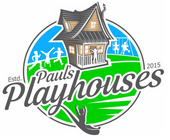
10 Things to Consider Before Building a Playhouse
With the weather getting warmer and the kids starting to get older, you may be looking for a way to encourage them to put down the game controller and spend some time in the great outdoors, even if it's just your backyard.
You could purchase one of those pre-made playsets from a big box hardware store, but you yourself are looking for a fun project both you and your child can engage in. You both decide that building a playhouse is a great idea and something you'll enjoy constructing together. But before you dive right in, there are a few things you should take into consideration first. Here is my list of 10 things to consider before starting a playhouse.
1. Assess Your Skill Level
Be honest with yourself. Can you preform the most fundamental acts of carpentry? Things like properly reading a tape? Making a compound cut or even making a straight cut with a circular saw? If using a chisel, swinging a hammer or making a 30 degree cut with a circular saw seems overly intimidating, you may want to consider the costs of hiring a local handyman to aid you in the build. If you think you can handle these beginner concepts, you probably can build at least a simple wooden playhouse.We offer a varying degree of playhouses with the most simple being the free outdoor hideaway. If that is a bit too plain for your liking and want something a bit more elaborate and challenging, we recommend trying your hands on our classic playhouses or even the full-sized playhouse plans. Which ever design you ultimately choose, be forthright with yourself and don't bite off more than what you can chew.
2. Analyze Your Budget
This is another major limiting factor that defiantly should be considered before starting any project for that matter. You may be the best carpenter in the world, but if don't have two dimes to rub together, you aren't going to get too far with your playhouse project. For even smaller playhouses with the most basic building materials, the final cost of the lumber, paint, brushes, roofing material and miles driven back and forth to buy this stuff can cost you no less than $200-300 for the most basic design.
For most people, expect to spend between $700-1200 and up and over $4000 for the large and elaborate designs offered on-line. One important thing to remember, however, is that despite spending several hundred dollars on this endeavor, it is still far cheaper to do it yourself than hiring a professional to come in a install it for you. Most of their cost is the labor and usually accounts for over 2/3 the asking price in many cases.
3. Tools ⇢
Do you have the tools, or to rephrase, the right type of tools for the job? There is also a difference between absolute necessity and convenience too. Circular saw? Absolutely necessary. Miter saw? Very helpful but still a convenience. Here is a quick list of the two.Absolutely necessary:
- Pencil
- Speed square
- Hammer
- Tape measure
- Circular saw
- Drill
Convenient:
- Miter Saw
- Table Saw
- Reciprocating saw
- Jig Saw
- Impact Driver
- Sander
- Chisel
It's up to you to decide if having any of the nicer more convenient type of tools are worth trading saved time and hassle with the cash you'll have to part with.
4. Yard Space
How big is your yard? You may have enough room to build a large barn design, but will there be enough room for the other activities you use it for? Even if you have enough room for several playhouses, it may not the most aesthetically pleasing idea. Most of this is just personal preference, what you are will to tolerate for the next ten years.
One important thing to keep in mind about building on your land are property setbacks. Often there is a no-build-zone surrounding the edge of your property. Check with your township on the exact setback distance for you. This leads right into the next thing to consider.
5. Neighbors
Before building anything, taking the first step in diplomacy and taking to your neighbors about your construction plans is almost always a good idea. I've witnessed several times where neighbors come out surprised and angered that there is a new tree house or zip line being installed very close to their properly. We've even had township inspectors stop by based on passive aggressive neighbors who didn't approve of the new playhouse being installed. While notoriously mean nearby residents might deserve a 2nd thought, normally communicating with your neighbors is the idea choice.6. Choosing the Type of Playhouse
Now we're getting to the fun part about all this decision making. Talking with your kids and going over the many different styles, sizes, colors and accessories is the most rewarding part before the thing actually gets built. Are you and your kids looking for a more traditional house style playhouse or something different, like a pirate ship or a fire engine? There are all kinds of options to pick from, just make sure to keep these other pointers in mind when making that decision. I also recommend looking at what makes a good child's playhouse.7. Lumber Type
This isn't one many people think about at first but it's still very important, especially for keeping the budget in check. Some people simply want the best, but the best is expensive and hard to find. Others want to cheap out when really they should have spent a little more money to get something that'll last. Our building material page goes into more detail, but here is what you generally should do.If you have a playhouse that has a water tight roof that protects the entire structure, normal non-pressure treated lumber is fine. This can include pine and Douglas fir. Cedar, mahogany, red wood or something else is fine, but the only downside is that it will cost you more. However, a project that is partially or fully exposed to the elements, something more than normal lumber is a must. The most cost effective method is to use pressure treated lumber. There have been concerns regarding the safety of PT wood and children, but with modern preservation techniques, these suppositions are not warranted.
Cedar, red wood and other harder material is fine too. Painting or staining your playhouse is another great idea for preserving the lumber too. For non-pressure treated types, it can be applied right away with no negative repercussions. For pressure treated, waiting about a year is the best approach, as new pressure treated lumber is already saturated and won't take paint or stain very well.
8. Time management
Along with your skill and budget limitations, what time resources do you have to get this project off the ground? Are you week day and week ends always filled or have expected activities popping in? Maybe this is your busy season and just need to wait it out until your schedule flattens out. Whatever the reason, make sure that you'll be able to allocate the necessary time to build your child's playhouse. For most people, it can take 2-3 full days to build a normal clubhouse, and up to a week for the large projects. Of course, this all can be accelerated if...9. Hired Help
Whether it be a family member, friend, neighbor or professional, getting someone to help is always a breath of fresh air. If they're more knowledgeable than you, it can be a great source of peace of mind.
Even if they have your same skill set, it can really help make the project go much faster. Having someone help hold a piece in place or carry lumber around can really take the stress off and make the entire project much more manageable. If you have someone in the roster who is willing to help, defiantly take advantage of that opportunity. Building playhouses can be a very social thing too!



